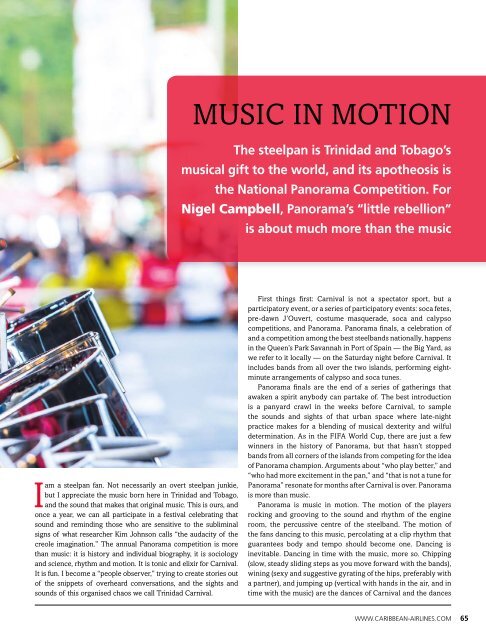Caribbean Beat — January/February 2017 (#143)
A calendar of events; music, film, and book reviews; travel features; people profiles, and much more.
A calendar of events; music, film, and book reviews; travel features; people profiles, and much more.
Create successful ePaper yourself
Turn your PDF publications into a flip-book with our unique Google optimized e-Paper software.
Music in motion<br />
The steelpan is Trinidad and Tobago’s<br />
musical gift to the world, and its apotheosis is<br />
the National Panorama Competition. For<br />
Nigel Campbell, Panorama’s “little rebellion”<br />
is about much more than the music<br />
I<br />
am a steelpan fan. Not necessarily an overt steelpan junkie,<br />
but I appreciate the music born here in Trinidad and Tobago,<br />
and the sound that makes that original music. This is ours, and<br />
once a year, we can all participate in a festival celebrating that<br />
sound and reminding those who are sensitive to the subliminal<br />
signs of what researcher Kim Johnson calls “the audacity of the<br />
creole imagination.” The annual Panorama competition is more<br />
than music: it is history and individual biography, it is sociology<br />
and science, rhythm and motion. It is tonic and elixir for Carnival.<br />
It is fun. I become a “people observer,” trying to create stories out<br />
of the snippets of overheard conversations, and the sights and<br />
sounds of this organised chaos we call Trinidad Carnival.<br />
First things first: Carnival is not a spectator sport, but a<br />
participatory event, or a series of participatory events: soca fetes,<br />
pre-dawn J’Ouvert, costume masquerade, soca and calypso<br />
competitions, and Panorama. Panorama finals, a celebration of<br />
and a competition among the best steelbands nationally, happens<br />
in the Queen’s Park Savannah in Port of Spain <strong>—</strong> the Big Yard, as<br />
we refer to it locally <strong>—</strong> on the Saturday night before Carnival. It<br />
includes bands from all over the two islands, performing eightminute<br />
arrangements of calypso and soca tunes.<br />
Panorama finals are the end of a series of gatherings that<br />
awaken a spirit anybody can partake of. The best introduction<br />
is a panyard crawl in the weeks before Carnival, to sample<br />
the sounds and sights of that urban space where late-night<br />
practice makes for a blending of musical dexterity and wilful<br />
determination. As in the FIFA World Cup, there are just a few<br />
winners in the history of Panorama, but that hasn’t stopped<br />
bands from all corners of the islands from competing for the idea<br />
of Panorama champion. Arguments about “who play better,” and<br />
“who had more excitement in the pan,” and “that is not a tune for<br />
Panorama” resonate for months after Carnival is over. Panorama<br />
is more than music.<br />
Panorama is music in motion. The motion of the players<br />
rocking and grooving to the sound and rhythm of the engine<br />
room, the percussive centre of the steelband. The motion of<br />
the fans dancing to this music, percolating at a clip rhythm that<br />
guarantees body and tempo should become one. Dancing is<br />
inevitable. Dancing in time with the music, more so. Chipping<br />
(slow, steady sliding steps as you move forward with the bands),<br />
wining (sexy and suggestive gyrating of the hips, preferably with<br />
a partner), and jumping up (vertical with hands in the air, and in<br />
time with the music) are the dances of Carnival and the dances<br />
WWW.CARIBBEAN-AIRLINES.COM 65


















